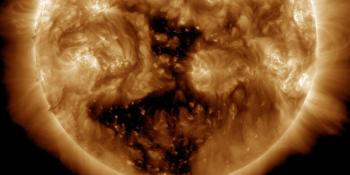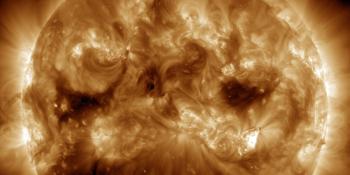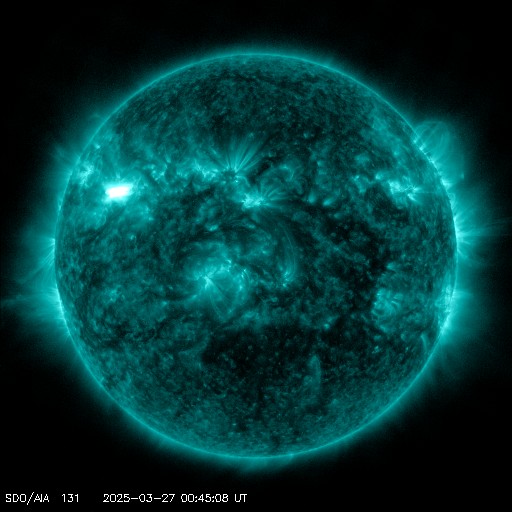Viewing archive of Friday, 4 November 2011
Solar activity report
Any mentioned solar flare in this report has a scaling factor applied by the Space Weather Prediction Center (SWPC). Because of the SWPC scaling factor, solar flares are reported as 42% smaller than for the science quality data. The scaling factor has been removed from our archived solar flare data to reflect the true physical units.
Report of Solar-Geophysical Activity 2011 Nov 04 2200 UTCPrepared by the NOAA © SWPC and processed by SpaceWeatherLive.com
Joint USAF/NOAA Report of Solar and Geophysical Activity
SDF Number 308 Issued at 2200Z on 04 Nov 2011IA. Analysis of Solar Active Regions and Activity from 03-2100Z to 04-2100Z
Solar activity was moderate. Region 1339 (N19E45)
produced two M-class flares during the past 24 hours; an M2 at
03/2336Z and an M1/Sf at 04/2040Z. Region 1339 continues to dominate
the disk in terms of sunspot area (about 1540 millionths) and
complexity (Fkc beta-gamma-delta). The region did not show a strong
growth or decay trend. A fast, asymmetric full halo CME was observed
to enter the LASCO C2 field of view at 03/2312Z and had an estimated
plane of sky speed of about 1100 km/s. Observations from the STEREO
spacecraft indicate this was a back-sided event. An additional CME
was observed in the C2 coronagraph at 04/0248Z off the east limb.
STEREO-B coronagraph observations appeared to show this as a full
halo CME and post-eruption loops were visible extending above the
east limb in the GOES SXI imagery. These observations suggest a
source that is just behind the east limb. Region 1338 (S14E28)
continues to be of moderate size (about 240 millionths) but was
quiet and stable.
IB. Solar Activity Forecast
Solar activity is expected to be
moderate. Additional M-flares are likely with Region 1339 as the
most probable source although the region behind east limb could also
contribute. There is a slight chance for an additional major flare
event from Region 1339.
IIA. Geophysical Activity Summary 03-2100Z to 04-2100Z
The geomagnetic field was quiet. A proton enhancement was observed at
the GOES satellites, beginning at about 0100Z and rising to a peak
of 3.6 PFU (greater than 10 MeV) at 0905Z. The flux levels slowed
decreased thereafter.
IIB. Geophysical Activity Forecast
The geomagnetic field is
expected to be quiet to unsettled for the next two days (05-06
November). A slight increase in activity is predicted due to a small
but favorably positioned coronal hole. Quiet levels are expected to
prevail for the third day (07 November).
III. Event Probabilities 05 Nov to 07 Nov
| Class M | 65% | 65% | 65% |
| Class X | 10% | 10% | 10% |
| Proton | 05% | 05% | 10% |
| PCAF | green | ||
IV. Penticton 10.7 cm Flux
Observed 04 Nov 164 Predicted 05 Nov-07 Nov 165/165/170 90 Day Mean 04 Nov 126
V. Geomagnetic A Indices
Observed Afr/Ap 03 Nov 003/003 Estimated Afr/Ap 04 Nov 007/008 Predicted Afr/Ap 05 Nov-07 Nov 007/010-007/008-005/005
VI. Geomagnetic Activity Probabilities 05 Nov to 07 Nov
| A. Middle Latitudes | |||
|---|---|---|---|
| Active | 20% | 15% | 05% |
| Minor storm | 05% | 01% | 01% |
| Major-severe storm | 01% | 01% | 01% |
| B. High Latitudes | |||
|---|---|---|---|
| Active | 25% | 20% | 10% |
| Minor storm | 15% | 10% | 05% |
| Major-severe storm | 05% | 01% | 01% |
All times in UTC
Latest news
Latest forum messages
AR4043 17Large Coronal Hole 25 152Photographing auroras 36Aurora photography hints for those of us with smartphones 43More on an art than a science 3
More topicsSupport SpaceWeatherLive.com!
A lot of people come to SpaceWeatherLive to follow the Sun's activity or if there is aurora to be seen, but with more traffic comes higher server costs. Consider a donation if you enjoy SpaceWeatherLive so we can keep the website online!

Latest alerts
09:15 UTC - Geomagnetic activity
Minor G1 geomagnetic storm (Kp5) Threshold Reached: 08:59 UTC
06:27 UTC - Hemispheric Power Index
The OVATION model predicts the Hemispheric Power Index to reach 54GW at 07:01 UTC
06:00 UTC - Geomagnetic activity
Minor G1 geomagnetic storm (Kp5) Threshold Reached: 05:51 UTC
00:57 UTC - Solar flare
Moderate M2.05 flare
00:33 UTC - Radio Blackout
Minor R1 radio blackout in progress (≥M1 - current: M1.71)
Space weather facts
| Last X-flare | 2025/02/23 | X2.0 |
| Last M-flare | 2025/03/27 | M2.0 |
| Last geomagnetic storm | 2025/03/26 | Kp6+ (G2) |
| Spotless days | |
|---|---|
| Last spotless day | 2022/06/08 |
| Monthly mean Sunspot Number | |
|---|---|
| February 2025 | 154.6 +17.6 |
| March 2025 | 132.3 -22.3 |
| Last 30 days | 131.2 -21.8 |




